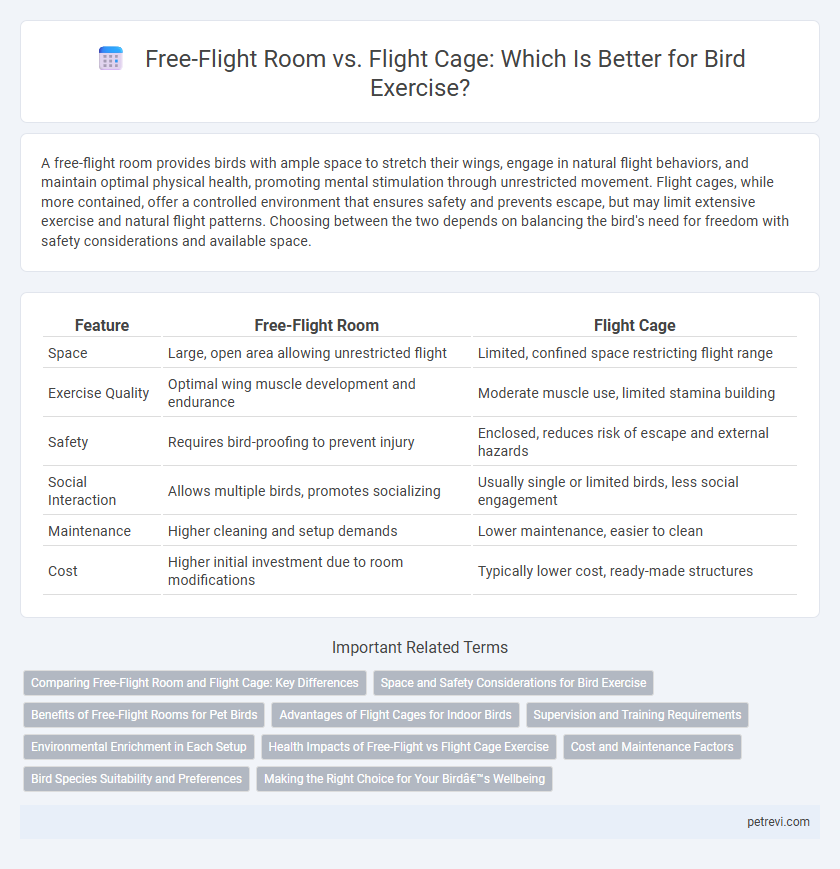A free-flight room provides birds with ample space to stretch their wings, engage in natural flight behaviors, and maintain optimal physical health, promoting mental stimulation through unrestricted movement. Flight cages, while more contained, offer a controlled environment that ensures safety and prevents escape, but may limit extensive exercise and natural flight patterns. Choosing between the two depends on balancing the bird's need for freedom with safety considerations and available space.
Table of Comparison
| Feature | Free-Flight Room | Flight Cage |
|---|---|---|
| Space | Large, open area allowing unrestricted flight | Limited, confined space restricting flight range |
| Exercise Quality | Optimal wing muscle development and endurance | Moderate muscle use, limited stamina building |
| Safety | Requires bird-proofing to prevent injury | Enclosed, reduces risk of escape and external hazards |
| Social Interaction | Allows multiple birds, promotes socializing | Usually single or limited birds, less social engagement |
| Maintenance | Higher cleaning and setup demands | Lower maintenance, easier to clean |
| Cost | Higher initial investment due to room modifications | Typically lower cost, ready-made structures |
Comparing Free-Flight Room and Flight Cage: Key Differences
Free-flight rooms provide birds with a larger, more natural space that encourages extensive wing exercise and unrestricted movement, promoting better physical and mental health. Flight cages, while more confined, offer controlled environments that enhance safety and manageability but may limit flight range and natural behavior. Choosing between the two depends on balancing the bird's need for exercise with safety, space availability, and supervision requirements.
Space and Safety Considerations for Bird Exercise
A free-flight room provides birds with ample space to fly freely, promoting natural exercise and mental stimulation while reducing stress levels. Flight cages restrict movement but offer enhanced safety by preventing collisions, escapes, and exposure to household hazards. Choosing between the two depends on balancing the bird's need for spacious exercise with ensuring a secure environment to prevent injury or accidents.
Benefits of Free-Flight Rooms for Pet Birds
Free-flight rooms provide pet birds with ample space to stretch their wings and engage in natural flying behaviors, significantly enhancing their physical health and muscle development. Unlike flight cages, free-flight rooms reduce stress and behavioral problems by offering a more stimulating and less restrictive environment. The increased freedom of movement in free-flight rooms promotes mental well-being and social interaction, contributing to a happier and more active bird.
Advantages of Flight Cages for Indoor Birds
Flight cages provide indoor birds with ample space to flap, stretch, and engage in natural flight behaviors, promoting physical health and muscle development. They offer a controlled environment that prevents birds from flying into hazards while allowing them to exercise safely. The structure and size of flight cages also facilitate social interaction and mental stimulation, essential for the well-being of indoor birds.
Supervision and Training Requirements
Free-flight rooms provide birds with a larger, more natural environment that allows for extensive exercise and encourages natural flying behaviors, but they require constant supervision and advanced training to prevent accidents and ensure the bird's safety. Flight cages offer a controlled space with limited flight area, reducing the risk of injury and escape while requiring less intensive supervision and less comprehensive training for the bird. Choosing between a free-flight room and a flight cage depends heavily on the bird owner's ability to maintain strict oversight and invest in consistent bird training practices.
Environmental Enrichment in Each Setup
A free-flight room provides birds with ample space to exercise natural flying behaviors, promoting mental and physical stimulation through varied flight paths and landing spots that mimic a natural environment. Flight cages offer controlled environments where birds can engage in moderate exercise, but the limited space may reduce opportunities for diverse movement and environmental interaction. Incorporating perches, toys, and natural elements in both setups enriches the bird's environment, enhancing their cognitive health and reducing stress.
Health Impacts of Free-Flight vs Flight Cage Exercise
Free-flight rooms allow birds to engage in natural wing movements and full-body exercise, promoting cardiovascular health, muscle development, and mental stimulation essential for overall well-being. Flight cages, while providing space for limited movement, often restrict wing span and reduce opportunities for dynamic flight, potentially leading to muscle atrophy and increased stress levels. Studies indicate that birds exercised in free-flight environments exhibit lower incidences of obesity, improved respiratory function, and enhanced behavioral health compared to those confined to flight cages.
Cost and Maintenance Factors
Free-flight rooms require higher initial costs due to specialized construction and soundproofing, while flight cages are more affordable and easier to set up. Maintenance for free-flight rooms involves regular cleaning, structural inspections, and potential repairs to walls and windows, whereas flight cages need routine cage cleaning and occasional hardware replacement. Choosing between the two options depends on budget constraints and desired exercise environment for the bird's safety and well-being.
Bird Species Suitability and Preferences
Free-flight rooms provide ample space for larger bird species like parrots and cockatoos to exercise natural flight behaviors, while flight cages suit smaller birds such as finches and canaries that require less space but still benefit from controlled wing movement. Species with high energy levels and strong flight muscles thrive in free-flight environments, promoting physical health and mental stimulation. Conversely, less active or more timid species prefer flight cages that offer security and ease of access to food and water.
Making the Right Choice for Your Bird’s Wellbeing
A free-flight room provides ample space for natural wing movement and mental stimulation, significantly promoting a bird's physical and psychological health. Flight cages, while more confined, offer controlled safety and easier supervision, preventing potential injuries and escapes. Assessing your bird's species, size, and temperament is crucial to making the right choice that ensures optimal exercise and overall wellbeing.
Free-Flight Room vs Flight Cage for Bird Exercise Infographic

 petrevi.com
petrevi.com